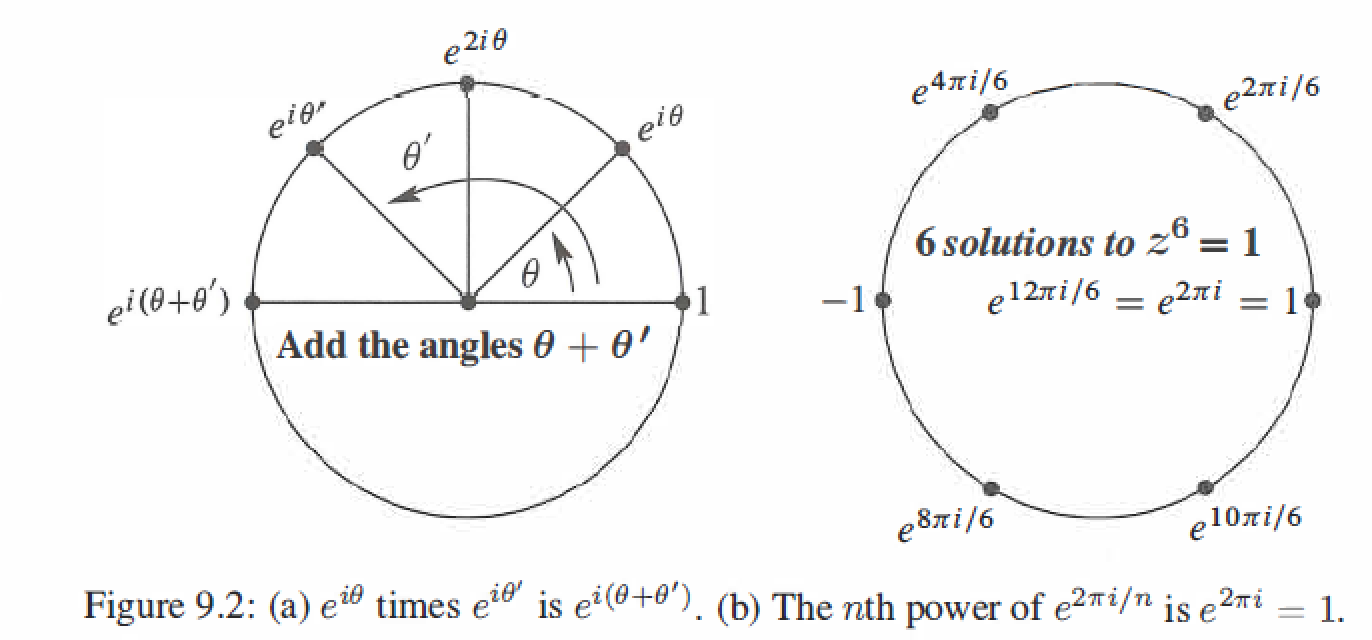9. Complex Vectors and Matrices
9.1 Real versus Complex
- R= line of all real numbers (\(-\infty < x < \infty\)) \(\longleftrightarrow\) C=plane of all complex numbers \(z=x+iy\)
- |x| = absolute value of x \(\longleftrightarrow\) \(|z| = \sqrt{x^2+y^2} = r\) = absolute value (or modulus) of z
- 1 and -1 solve \(x^2=1\) \(\longleftrightarrow\) \(z=1,w,...,w^{n-1}\) solve \(z^n=1\) where \(w = e^{2\pi i/n}\)
- \(R^n\) : vectors with n real components \(\longleftrightarrow\) \(C^n\): vectors with n complex components
- length : \(||x||^2 = x_1^2 + \cdots + x_n^2\) \(\longleftrightarrow\) \(||z||^2 = |z_1|^2 + \cdots + |z_n|^2\)
- transpose : \(A_{ij}^T = A_{ji}\) \(\longleftrightarrow\) conjugate transpose \(A_{ij}^H = \overline{A_{ji}}\)
- dot/inner product : \(x^Ty = x_1y_1 + \cdots + x_ny_n\) \(\longleftrightarrow\) dot/inner product : \(u^Hv = \overline{u_1}v_1 + \cdots + \overline{u_n}v_n\)
- reason for \(A^T\) : \((Ax)^Ty = x^T(A^Ty)\) \(\longleftrightarrow\) reason for \(A^H\): \((Au)^Hv = u^H(A^Hv)\)
- orthgonality : \(x^Ty = 0\) \(\longleftrightarrow\) orthgonality : \(u^Hv = 0\)
- symmetric matrices: \(S=S^T\) \(\longleftrightarrow\) Hermitian matrices: \(S=S^H\)
- skew-symmetric matrices : \(K^T = K^{-1}\) \(\longleftrightarrow\) skew-Hermitian matrices : \(K^H = -K\)
- orthgonal matrices : \(Q^T = Q^{-1}\) \(\longleftrightarrow\) unitary matrices : \(U^H = U^{-1}\)
- orthonormal matrices : \(Q^TQ = I\) \(\longleftrightarrow\) orthonormal matrices : \(U^HU = I\)
- \(S = Q\Lambda Q^{-1} = Q\Lambda Q^T\) \(\longleftrightarrow\) \(S = U\Lambda U^{-1} = U\Lambda U^H\)
- \((Qx)^T(Qy)= x^Ty\) and \(||Qx|| = ||x||\) \(\longleftrightarrow\) \((Ux)^H(Uy)= x^Hy\) and \(||Uz|| = ||z||\)
9.2 Complex Numbers
Complex numbers correspond to points in a plane. Real numbers go along the x axis.Pure imaginary numbers are on the y axis. The complex number \(a+bi\) is at the point with coordinates (a, b).

Keys:
-
Add : \((a + bi) + (c + di) = (a+c)+(b+d)i\)
-
Multiply : \((a+bi)(a-bi)=a^2+b^2\)
-
Eigenvalues \(\lambda\) 和 \(\overline{\lambda}\) : If \(Ax=\lambda x\) and A is real then \(A\overline{x}=\overline{\lambda}\overline{x}\)
-
Euler's Formula : \(e^{i\theta}= cos\theta + isin\theta\)
-
Polar Form : The number \(z=a+ib\) is also \(z=rcos\theta + irsin\theta = re^{i\theta} \ \ with \ \ r = |z| = \sqrt{a^2 + b^2}\)
-
Powers: The nth power of \(z=r(cos\theta+isin\theta)\) is \(z^n=r^n(cos(n\theta)+isin(n\theta))\)
-
The nth roots of 1 : Set \(w=e^{2\pi i/n}\), the nth powers of \(1,w,w^2,...,w^{n-1}\) all equal 1, they solve the equation \(z^n=1\)

9.3 Hermitian and Unitary Matrices
When we transpose a complex vector z or matrix A , also take the complex conjugate too.
With \(z_j = a_j + i b_j\):
conjugate transpose : \(\overline{z}^T=[\overline{z_1} \cdots \overline{z_n}] = [a_1 - ib_1 \cdots a_n - ib_n]\)
length squared : \([\overline{z_1} \cdots \overline{z_n}] \left[ \begin{matrix} z_1 \\ \vdots \\ z_n\end{matrix}\right]= |z_1|^2 + \cdots + |z_n|^2 \longleftrightarrow \overline{z}^Tz=z^Hz = ||z||^2\) (\(z^H\) is z Hermitian)
Inner product : \(u^{H}v = [\overline{u_1} \cdots \overline{u_n}] \left[ \begin{matrix} v_1 \\ \vdots \\ v_n\end{matrix}\right]= \overline{u_1}v_1 + \cdots + \overline{u_n}v_n\)
Hermitian Matrix
Among complex matrices, with Hermitian matrices : \(S=S^H, s_{ij} = \overline{s_{ji}}\)
Eigenvalues of a Hermitian matrix is real, and eigenvectors of a Hermitian are orthogonal.
Unitary Matrices
A unitary matrix Q is a complex square matrix that has orthonormal columns.
Unitary matrix that diagonalizes S : \(Q=\frac{1}{\sqrt{3}}\left[ \begin{matrix} 1&1-i \\ 1+i&-1 \end{matrix}\right]\)
Orthonormal columns : \(Q^HQ=I\)
Square + Orthonormal columns = Unitary matrix : \(Q^{H} = Q^{-1}\)
If Q is unitary the \(||Qz||=||z||\). Therefore \(Qz=\lambda z\) leads to \(|\lambda| = 1\)
9.4 The Fast Fourier Transform
Fourier Matrix
example:
\(F_4\) is orthogonal and symmetric.
\(w_4 = e^{\pi / 2 * i} \\ F_4^{H}F_4 = I, \ \ F^{-1}_4 = \frac{1}{4}\overline{F}_4\)
The key idea is to connect \(F_n\) with the half-size Fourier matrix \(F_{n/2}\), and keep going to \(F_{n/4}\),which can be factored in a way that procdeces many zeros, and improve multiply quickly.
Save more than half of time : \(n^2 \Rightarrow 1/2 n log_2^n\)





